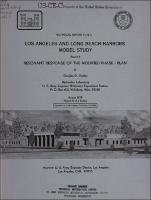Please use this identifier to cite or link to this item:
https://hdl.handle.net/11681/13117| Title: | Los Angeles and Long Beach Harbors Model Study. Report 6, Resonant response of the modified phase I plan |
| Authors: | United States. Army. Corps of Engineers. Los Angeles District Outlaw, Douglas G. |
| Keywords: | Harbor oscillations Long Beach Harbor (Calif.) Harbors Ports Los Angeles Harbor Hydraulic models Water waves |
| Publisher: | Hydraulics Laboratory (U.S.) Engineer Research and Development Center (U.S.) |
| Series/Report no.: | Technical report (U.S. Army Engineer Waterways Experiment Station) ; H-75-4 rept.6. |
| Description: | Technical Report Abstract: A study of harbor resonance due to long-period wave excitation was conducted in the Los Angeles and Long Beach Harbor s hydraulic model for the Modified Phase I improvement plan and compared with resonant response for existing conditions. Proposed improvements for the Modified Phase I plan included dredging of navigation channels and an associated landfill of approximately 200 acres in the Port of Los Angeles, and an Outer Harbor Oil Terminal in the Port of Long Beach. Wave periods ranging from 15.5 to 410 sec with incident direction of approach from the south were included in the study. Previous refraction studies had shown that due to offshore topography, Los Angeles and Long Beach Harbors are well protected from all incident long-period wave directions, except from the south. Results of the study show wave-height amplification, periods of maximum response, and modes of oscillation for various berthing areas. Comparisons of model data for existing conditions and the proposed plan indicated that resonant modes of oscillation in the existing harbor berthing areas were not substantially altered. With the Modified Phase I plan, periods of maximum resonant amplification in existing harbors generally shifted slightly. Resonant peaks in the amplification data generally decreased or increased slightly. For existing conditions, periods of maximum response agreed closely with prototype measurements. In the proposed Outer Harbor Oil Terminal, modes of oscillation either resulted in antinodes in the berthing areas or had relatively low amplification. |
| Rights: | Approved for public release; distribution is unlimited. |
| URI: | http://hdl.handle.net/11681/13117 |
| Appears in Collections: | Technical Report |
Files in This Item:
| File | Description | Size | Format | |
|---|---|---|---|---|
| TR-HL-75-4-Report-6.pdf | 11.13 MB | Adobe PDF |  View/Open |